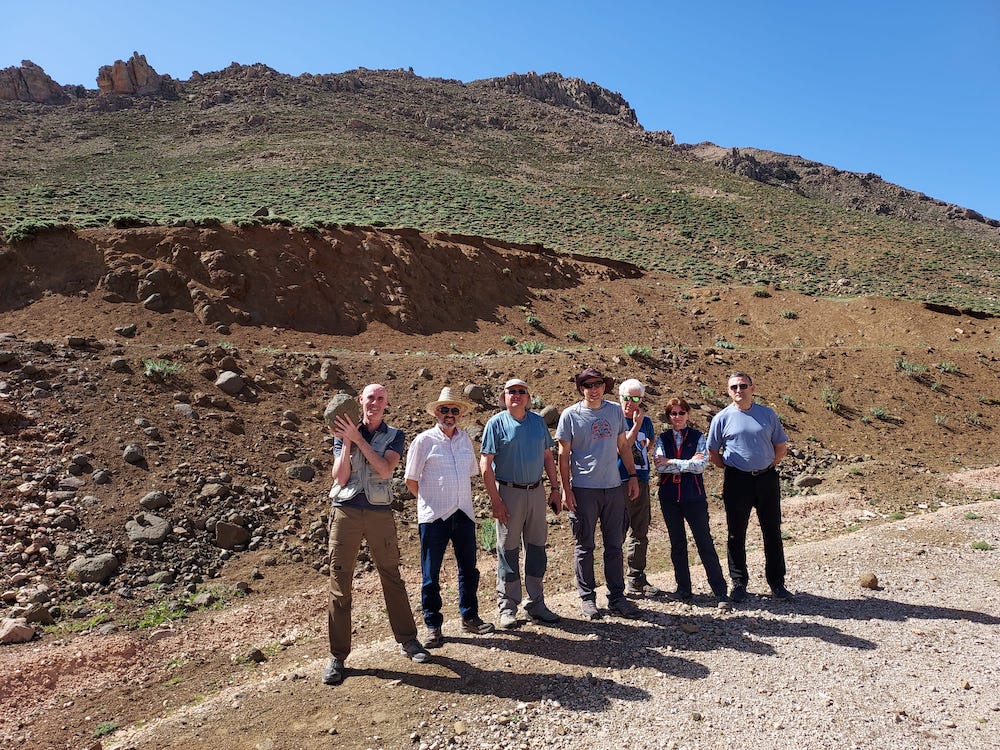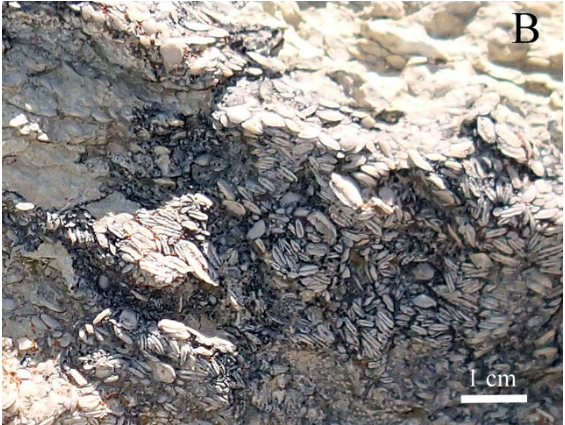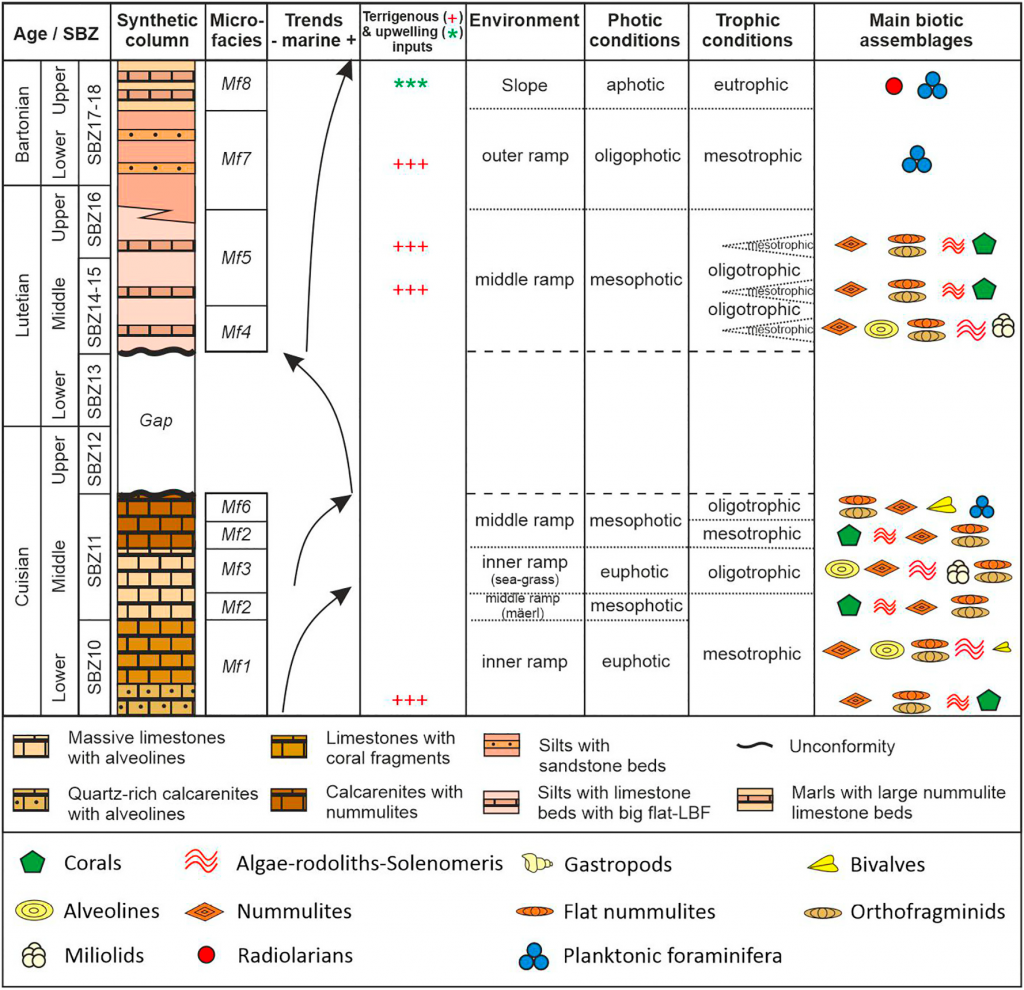Home » Eocene
Category Archives: Eocene
Field trip in Morocco: Searching for the Nummulites
The Africa call…
Well the third field work campaign the project. This time in the Middle Atlas of Morocco. The objetive was to find Nummulites as the ones in the Betic or in the Rif.
The picture shows the members of the team. Picture taken by Soufian Maaté.

Manuel Bullejos Lorenzo (Granada University)
Rachid Hlila (Abdelmalek Essaádi University)
Ali Maaté (Abdelmalek Essaádi University)
Manuel Martín-Martín (Alicante University)
Soufian Maaté (Moulay Ismail Errachidia University)
Crina Miclăuș (Alexandru Ioan Cuza University)
José Enrique Tent-Manclús (Alicante University)
And the collaborators:
Pedro Robles (Alicante University)
Santiago Moliner (Alicante University).
After a week (from April 23rd until April 30 2023). Many rock samples were taken and we did not find them but our hope is to look carefully the thin sections for tiny Nummulites.
This is the third major field trip of the project of the Spanish research agency (Agencia Estatal de Investigación) of the Spanish Science and innovation minister (Ministerio de Ciencia e Innovación) entitle as “EVOLUCION TECTONO-DEPOSICIONAL DE CUENCAS SEDIMENTARIAS CENOZOICAS: CARACTERIZACION 2D-3D Y MEJORA DE PATRONES ESTANDAR” (PID2020-114381GB-I00). See previous post.
Small scale RT cycles in Prebetic Lower-Middle Eocene (Alicante)
In the study of the Alicante External Prebetic Eocene platforms, ten sedimentary facies were defined in field based on lithology and fossil content observed, as follows: L1 – limestone (lmst.) with Alveolina; L2 – lmst. with small Nummulites (< 3 cm diameter); L3 – lmst. with big Nummulites (>3 cm diameter); L4 – algal lmst.; L5 – lmst. with miliolids; L6 – micritic lmst. with gastropods and bivalves; L7 – marls; L8 – greenish siltstones; L9 – dolomitized lmst. and/or dolostone; L10 – sandy lmst.
The lower interval of the Ibi section twelve L2-L1 units were defined, after which the first dolomitized limestone (L9) occurs, changing the motif to L2-L1-L9 or L1-L9. The middle part of the succession is marked by the occurrence of facies L10, while the upper part by five units with L5-L7.
The lower interval of the Ibi section, consists of thinning-upward units, each one showing a shallowing-upward trend, indicating a decrease of accommodation in middle ramp area, ended with the basinward shift of the proximal open inner ramp. The upper interval, consisting in thickening-upward units, sedimented in lagoon-shoals of inner ramp, indicates increasing of accommodation. This interval is preceded by a period of siliciclastic supply (L10). Consequently, at the scale of the entire outcrop a regressive sequence can be defined with at least 12 smaller RT (Regressive-transgressive) cycles, the lower 6 developed in middle ramp environments, while the upper 6 in inner ramp.

The Prebetic Paleocene-Eocene stratigraphic succession shows a general regressive-transgressive trend. The above-presented results indicate that on the regressive interval of this trend smaller scale RT cycles are superposed.
Cite as: Miclăuș, C., Martín-Martín, M., Tosquella, J., Samsó, J.M. and Tent-Manclús, J.E. (2023): Small scale RT cycles in Lower-Middle Eocene limestones of External Prebetic Units of Betic Cordillera (Alicante Zone). Abstract Book, Fourteenth Romanian Symposium on Palaeontology, Bucharest, 14-15 September 2023 / Zoltán Csiki-Sava, Alina Floroiu, Maria-Raluca Văcărescu, Iuliana Lazăr – Bucureşti : Editura Universităţii din Bucureşti -Bucharest University Press, 2023, 83-84 p.
New biostratigraphic data on the Paleocene-Eocene from the Prebetic
A biostratigraphic study of the Paleocene-Eocene of the stratigraphically continuous with the northern foreland (Iberian Meseta), Prebetic has been studied by using planktonic foraminifera, calcareous nannoplankton, and larger benthic foraminifera. Twelve sections have been studied along the chain: four sections in the Alicante Sector, four in the Murcia Sector, two in the Granada Sector, and two sections in the Jaén Sector.
The Paleocene-Eocene Prebetic succession can be divided into three stratigraphic formations related by lateral and diachronic changes of facies: limestones and calcarenites (rich in larger benthic foraminifera) in middle stratigraphic position, and two marly-clayey formations in lower and upper positions, respectively. The middle unit represents an internal marine platform, while the two marly-clayey represent the external platform (and the upper slope in a few cases). As a whole, above the unconformity, representing the missing interval which includes the Cretaceous-Paleocene boundary.

Cite as: Martín-Martín, M., Miclăuș, C., Serrano, F., Tosquella, J., Samsó, J.M., Tent-Manclús, J.E., and Martín-Pérez, J.A. (2023): New biostratigraphic data on the Paleocene-Eocene succession from the Prebetic domain (Betic Cordillera: South Spain).Abstract Book, Fourteenth Romanian Symposium on Palaeontology, Bucharest, 14-15 September 2023 / Zoltán Csiki-Sava, Alina Floroiu, Maria-Raluca Văcărescu, Iuliana Lazăr – Bucureşti : Editura Universităţii din Bucureşti -Bucharest University Press, 2023, 79-80 p.

Recent Comments